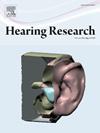Alterations in brain activity and functional connectivity originating residual inhibition of tinnitus induced by tailor-made notched music training
IF 2.5
2区 医学
Q1 AUDIOLOGY & SPEECH-LANGUAGE PATHOLOGY
引用次数: 0
Abstract
Tinnitus arises from the intricate interplay of multiple, parallel but overlapping networks, involving neuroplastic changes in both auditory and non-auditory activity. Tailor-made notched music training (TMNMT) has emerged as a promising therapeutic approach for tinnitus. Residual inhibition (RI) represents one of the rare interventions capable of temporarily alleviating tinnitus, offering a valuable tool that can be applied to tinnitus research to explore underlying tinnitus mechanisms. To our knowledge, this study is the first to investigate the neural mechanisms underlying the RI effect of TMNMT through analysis of neural source activity and functional connectivity of EEG. Forty-four participants with tinnitus were divided into TMNMT group (twenty-two participants; ECnm, NMnm, RInm represented that EEG recordings with eyes closed stimuli-pre, stimuli-ing, stimuli-post by TMNMT music, respectively) and Placebo control group (twenty-two participants; ECpb, PBpb, RIpb represented that EEG recordings with eyes closed stimuli-pre, stimuli-ing, stimuli-post by Placebo music, respectively) in a single-blind manner. Source localization analysis revealed that RI effect of TMNMT significantly increased in current density at the delta band in the insula, subgenual anterior cingulate cortex (sgACC), parahippocampus (PHC), and secondary auditory cortex (AⅡ), and significantly increased in current density at the theta band in the sgACC, and significantly decreased in current density at the alpha band in the precuneus, PHC, primary (AI) and secondary (AII) auditory cortex. Meanwhile, RI effect of Placebo significantly decreased in current density at the alpha band in the PHC. Functional connectivity analysis demonstrated that RI effect of TMNMT significantly increased in phase coherence between the left AⅡ and the right sgACC; and between the left PHC and the left retrosplenial cortex (RSC) at the theta band. It significantly decreased in phase coherence between the left PHC and the right precuneus, the right posterior cingulate cortex (PCC), the right AⅡ; between the right PHC and the right PCC; and between the right PCC and the right AⅡ at the alpha band. RI effect of Placebo significantly increased in phase coherence between the left insula and the right precuneus, the left PHC, the right PHC, the left AⅠ, the left AⅡ; between the left sgACC and the right PHC; between the left AⅡ and the right PHC, the left PCC at the delta band. It was found that the current density of sgACC was significantly positively correlated with the tinnitus evaluation indicators (Loudness, VAS, THI, TFI) at the alpha band in TMNMT group. These findings indicated that TMNMT, a novel music therapy for tinnitus, revealed a robust RI effect, and RI effect of TMNMT was not only involved in the activity of auditory networks (AⅠ, AⅡ), but also extended to non-auditory networks, particularly higher-level auditory association cortices, such as the sgACC, PHC and PCC. The current study provides valuable experimental evidence and promising practical prospects for the potential applications of TMNMT in tinnitus treatment.
量身定制的缺口音乐训练引起的耳鸣残余抑制引起的脑活动和功能连接的改变
耳鸣是由多个平行但重叠的神经网络的复杂相互作用引起的,涉及听觉和非听觉活动的神经可塑性变化。量身定制的缺口音乐训练(TMNMT)已成为一种有前途的耳鸣治疗方法。残余抑制(RI)是一种罕见的能够暂时缓解耳鸣的干预措施,为耳鸣研究提供了一种有价值的工具,可以探索潜在的耳鸣机制。据我们所知,本研究首次通过分析脑电图的神经源活动和功能连通性来探讨TMNMT的RI效应背后的神经机制。44例耳鸣患者分为TMNMT组(22例;ECnm、NMnm、RInm分别代表闭眼时的脑电记录(刺激前、刺激后、刺激前)和安慰剂对照组(22名参与者;ECpb、PBpb、RIpb分别代表闭眼时(分别为安慰剂音乐刺激前、刺激后、刺激前)的脑电图记录。源定位分析显示,脑岛、亚掌前扣带皮层(sgACC)、副海马体(PHC)和次级听觉皮层(AⅡ)的δ带电流密度显著增加,sgACC的θ带电流密度显著增加,楔前叶、PHC、初级(AI)和次级(AII)听觉皮层的α带电流密度显著降低。同时,安慰剂的RI效应显著降低了PHC α带的电流密度。功能连通性分析表明,TMNMT的RI效应显著增加了左AⅡ和右sgACC之间的相位相干性;以及左PHC和左脾后皮层(RSC)之间的θ波段。左PHC与右楔前叶、右扣带后皮层、右AⅡ的相一致性显著降低;在正确的PHC和正确的PCC之间;在右边的PCC和右边的AⅡ之间。安慰剂的RI效应显著增加了左岛与右楔前叶、左PHC、右PHC、左AⅠ、左AⅡ之间的相一致性;在左sgACC和右PHC之间;在左AⅡ和右PHC之间,左PCC在δ波段。结果发现,TMNMT组sgACC电流密度与α波段的耳鸣评价指标(响度、VAS、THI、TFI)呈显著正相关。这些发现表明,作为一种新型的耳鸣音乐疗法,TMNMT显示出强大的听觉效应,并且TMNMT的听觉效应不仅涉及听觉网络的活动(aⅠ,aⅡ),而且还扩展到非听觉网络,特别是高级听觉关联皮层,如sgACC, PHC和PCC。本研究为TMNMT在耳鸣治疗中的潜在应用提供了有价值的实验依据和良好的实践前景。
本文章由计算机程序翻译,如有差异,请以英文原文为准。
求助全文
约1分钟内获得全文
求助全文
来源期刊

Hearing Research
医学-耳鼻喉科学
CiteScore
5.30
自引率
14.30%
发文量
163
审稿时长
75 days
期刊介绍:
The aim of the journal is to provide a forum for papers concerned with basic peripheral and central auditory mechanisms. Emphasis is on experimental and clinical studies, but theoretical and methodological papers will also be considered. The journal publishes original research papers, review and mini- review articles, rapid communications, method/protocol and perspective articles.
Papers submitted should deal with auditory anatomy, physiology, psychophysics, imaging, modeling and behavioural studies in animals and humans, as well as hearing aids and cochlear implants. Papers dealing with the vestibular system are also considered for publication. Papers on comparative aspects of hearing and on effects of drugs and environmental contaminants on hearing function will also be considered. Clinical papers will be accepted when they contribute to the understanding of normal and pathological hearing functions.
 求助内容:
求助内容: 应助结果提醒方式:
应助结果提醒方式:


